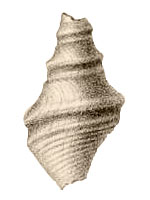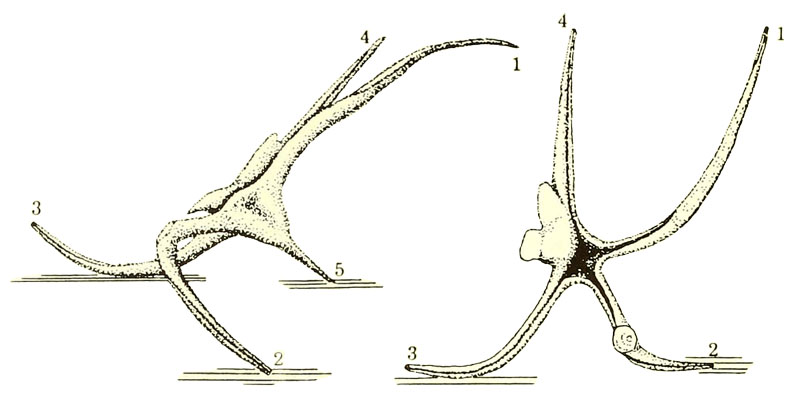Stromboidea
Original Description of Surcula (Surculites) inconspicua by Gabb, 1869, p. 151:
- "Shell small, spire high; whorls six (?), angulated, concave above and on the side; body whorl broad, rapidly tapering in advance. Surface marked by two large revolving ribs, one on the angle and one a little in advance; between these, and on the upper part of the whorl, the surface is covered with minute revolving lines; below the lower of the two ribs, the remainder of the shell is marked by small revolving ribs. Aperture broad, biangular posteriorly; outer lip notched above, produced below; inner lip slightly incrusted; canal moderate."
Measurements: "Length of fragment, .47 inch; total length of shell, about .55 inch; width of body whorl, .3 inch; length of aperture, .25-.28? inch."
Locus typicus: Mathewson, USA
Stratum typicum: Martinez Group, Martinez, Cretaceous
Surcula (Surculites) inconspicua Gabb, 1864, pl. XXVI, fig.29
History and Synonymy
1989
Tessarolax inconspicua in Saul, 1989, p. 20
Comment Saul, 1989, p. 20:
- "Tessarolax has four long curving digitations (1-4) extending from its aperture. Two sprout from the outer lip edge; one extends along and beyond the spire, and the fourth engulfs and extends beyond the rostrum. The posterior outer lip digitation (1) slopes toward the substrate, bends posteriorly, and turns away from the substrate near its distal end. The channel along the digitation begins on the apertural side, but migrates to the abapertural side. The distal third of the digitation, but not including the final upward portion, is flattened and appears abraded on the substrate side. The anterior outer lip digitation (2) slopes more abruptly toward the substrate, then more abruptly reverses slope and bends upward. The channel in the digitation begins on the apertural side, runs along the anterior side of the digitation at the bend, then migrates back to the labral side along its upturned portion. A rounded, thick callus pad that is abraded on its substrate side embellishes the bend. The rostral digitation (3) remains nearly in the plane of the shell axis, but distally has a somewhat downward slope. It engulfs the rostrum, extends anteriorly, and curves more or less strongly ablabrally. The channel remains on the apertural side of the digitation, and the rostral digitation is not worn, abraded, or flattened. The apical digitation (4) is the shortest of the four labral digitations; it slopes slightly upward at a narrow angle to the shell axis, and its channel remains on the apertural side of the digitation. In addition to the four labral digitations, the shell has a thick, knob-like to flange-like ablabral callus, a thick tongue of callus that extends along and beyond the spire, and a dorsal projection (5) that arises from the strong anterior rib of the last whorl and forms a relatively straight prong pointing away from the substrate. The entire mature shell is callus coated, and in a shell of approximately 3 cm height the digitation span commonly exceeds 11 cm."
References


